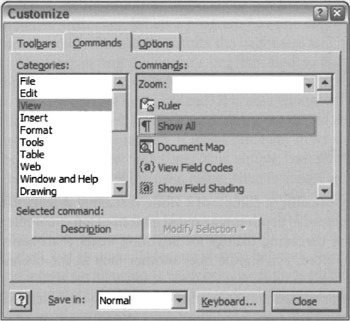Dynamic Dialogs
Most dialogs are static, presenting a fixed array of controls. A variant, the dynamic dialog, changes and adapts its suite of controls based on user input, even more so than the expanding dialog.
An example of a dynamic dialog can be found in the Customize dialog of Word 95 as shown in Figure 31-7. The controls on the face of the dialog change dynamically to adapt to the user's input to other controls on the same dialog. Depending on the selection the user makes in the Categories control, the contents of the Commands control changes. It's possible to swap out the entire Container control with something different; earlier versions of this dialog displayed butcons in a group-box, but fonts and macros in a list box filled with text items.

Figure 31-7: Word's Customize dialog box is an example of a dynamic dialog box. Depending on what you select in the Categories list box control, the Command list box to its right will contain controls (as shown), macros, font names, or other items.
This idiom has the potential to be confusing to users, as they wonder where certain controls went. But it is particularly effective when the user is entering settings in a clearly sequenced manner. For example, in a database access application where the user must first select a server, then a database on that server, then a table within that database, a dynamic dialog would be very appropriate. The structure of the problem calls for the server to be chosen first, so the user selects one from a list. As soon as the selection is made, the dialog configures itself to include a field for a password if the server requires it. As soon as the user selects the database, one or more fields then appear to allow the user to select the table, its owner, and other required information, in sequence.
Dialogs can become useful assistants that help your users accomplish their goals, instead of dreaded roadblocks that confound them at every step. By keeping your dialogs manageable, and invoking them only when their functions are truly those that belong in another room, you will go far towards maintaining your users' flow and ensuring their success and gratitude.
|
|
EAN: N/A
Pages: 263